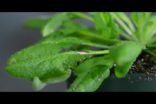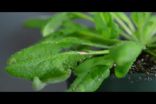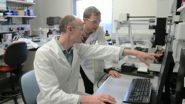(Press-News.org) VIDEO:
Experiments by Heidi Appel and Rex Cocroft at the University of Missouri mark the first time scientists have shown that a plant responds to an ecologically relevant sound in its...
Click here for more information.
COLUMBIA, Mo. – Previous studies have suggested that plant growth can be influenced by sound and that plants respond to wind and touch. Now, researchers at the University of Missouri, in a collaboration that brings together audio and chemical analysis, have determined that plants respond to the sounds that caterpillars make when eating plants and that the plants respond with more defenses.
"Previous research has investigated how plants respond to acoustic energy, including music," said Heidi Appel, senior research scientist in the Division of Plant Sciences in the College of Agriculture, Food and Natural Resources and the Bond Life Sciences Center at MU. "However, our work is the first example of how plants respond to an ecologically relevant vibration. We found that feeding vibrations signal changes in the plant cells' metabolism, creating more defensive chemicals that can repel attacks from caterpillars."
Appel collaborated with Rex Cocroft, professor in the Division of Biological Sciences at MU. In the study, caterpillars were placed on Arabidopsis, a small flowering plant related to cabbage and mustard. Using a laser and a tiny piece of reflective material on the leaf of the plant, Cocroft was able to measure the movement of the leaf in response to the chewing caterpillar.
Cocroft and Appel then played back recordings of caterpillar feeding vibrations to one set of plants, but played back only silence to the other set of plants. When caterpillars later fed on both sets of plants, the researchers found that the plants previously exposed to feeding vibrations produced more mustard oils, a chemical that is unappealing to many caterpillars.
"What is remarkable is that the plants exposed to different vibrations, including those made by a gentle wind or different insect sounds that share some acoustic features with caterpillar feeding vibrations did not increase their chemical defenses," Cocroft said. "This indicates that the plants are able to distinguish feeding vibrations from other common sources of environmental vibration."
Appel and Cocroft say future research will focus on how vibrations are sensed by the plants, what features of the complex vibrational signal are important, and how the mechanical vibrations interact with other forms of plant information to generate protective responses to pests.
"Plants have many ways to detect insect attack, but feeding vibrations are likely the fastest way for distant parts of the plant to perceive the attack and begin to increase their defenses," Cocroft said.
"Caterpillars react to this chemical defense by crawling away, so using vibrations to enhance plant defenses could be useful to agriculture," Appel said. "This research also opens the window of plant behavior a little wider, showing that plants have many of the same responses to outside influences that animals do, even though the responses look different."
The study, "Plants respond to leaf vibrations caused by insect herbivore chewing," was funded in part by the National Science Foundation and was published in Oecologia.
INFORMATION:
Editor's Note: For a longer version of this story, please visit: http://decodingscience.missouri.edu/2014/07/hearing-danger-appel-cocroft/
For an alternate video, please visit: http://www.youtube.com/watch?v=TKQ-CIX9afA
Plants respond to leaf vibrations caused by insects' chewing, MU study finds
2014-07-01
ELSE PRESS RELEASES FROM THIS DATE:
Reigning in chaos in particle colliders yields big results
2014-07-01
WASHINGTON D.C., June 30, 2014 – When beams with trillions of particles go zipping around at near light speed, there's bound to be some chaos. Limiting that chaos in particle colliders is crucial for the groundbreaking results such experiments are designed to deliver.
In a special focus issue of the journal Chaos, from AIP Publishing, a physicist at the European Organization for Nuclear Research (CERN) details an important method of detecting and correcting unwanted chaotic behavior in particle colliders. The method is helping accelerator physicists design high-performing, ...
Research reveals a gender gap in the nation's biology labs
2014-07-01
CAMBRIDGE, MA -- Among the sciences, biology consistently attracts the greatest numbers of women to graduate school and academic careers. About half of all biology graduate students are women, and 40 percent of biology postdocs are female. However, those numbers drop dramatically among faculty members: Nationwide, only 36 percent of assistant professors and 18 percent of full professors are women.
A new study reveals a possible explanation for this discrepancy: In the labs of the highest-achieving male biology professors — winners of the Nobel Prize, the National Medal ...
Study reveals that many people are oblivious to how they come across to counterparts and colleagues
2014-07-01
NEW YORK—Jill Abramson was recently ousted from her position as the executive editor of The New York Times for being, among other things, too "pushy." But did Abramson—who has also been described by the media as "polarizing" and "brusque"—know during the course of her tenure that others viewed her as being overly assertive? A new study from the Columbia Business School suggests that there's a great chance she didn't.
"Finding the middle ground between being pushy and being a pushover is a basic challenge in social life and the workplace. We've now found that the challenge ...
All the world's oceans have plastic debris on their surface
2014-07-01
However, central surface waters of the oceans may not be the final destination of plastic debris since, as indicated by the study performed by the Malaspina Expedition, large amounts of microplastics could be passing to the marine food chain and the ocean floor. Results of the study, led by the University of Cadiz (Spain), have been published in the journal Proceedings of the National Academy of Sciences (PNAS).
Andrés Cózar, researcher from the University of Cadiz, explains: "Ocean currents carry plastic objects which split into smaller and smaller fragments due to solar ...
Genetic evidence that body mass increases the risk of asthma in mid-childhood
2014-07-01
Some of the increase in asthma risk toward the end of the 20th century could be attributed to the increase in body mass index (BMI) in mid-childhood, according to new research published in this week's PLOS Medicine. The study, led by Raquel Granell from the University of Bristol, UK, and colleagues, provides genetic evidence that higher fat mass and lean mass increase the risk of asthma in mid-childhood.
The incidence of asthma, a chronic condition caused by inflammation of the airways, has been rising steadily over the past few decades, and it is estimated that 200� ...
Cesarean section linked to slight increase in future stillbirth and ectopic pregnancy
2014-07-01
Caesarean section is associated with a slightly increased rate of subsequent stillbirth and ectopic pregnancy, according to a large study of women living in Demark, published in this week in PLOS Medicine. Given the global increase in Caesarean rates, the results of the study, which was conducted by Louise Kenny and colleagues from University College Cork, Ireland and Aarhus University, Denmark, are of interest to pregnant women, their partners, and healthcare providers.
The researchers obtained data for 832,996 women from Danish national registers regarding their first ...
Catheter ablation a first-line treatment for atrial flutter
2014-07-01
Use of catheter ablation is not only beneficial for treating atrial flutter but also can significantly reduce hospital visits – both inpatient and emergency – and lower the risk for atrial fibrillation, according to research by UC San Francisco.
The study is in the July issue of PLOS ONE and available online.
"We've seen firsthand in our clinical experience that atrial flutter is difficult to control with drugs, even more than atrial fibrillation," said senior author Gregory Marcus, MD, director of clinical research in the UCSF Division of Cardiology. "Based on our ...
New insights from the modENCODE Project are published in Genome Research
2014-07-01
July 1, 2014 – Genome Research publishes six articles online and in print today describing recent advancements from the modENCODE Project. Initially launched in 2007, the goal of the modENCODE Project is to comprehensively characterize functional genomic elements in two model organisms, the fly Drosophila melanogaster, and the worm Caenorhabditis elegans. Comparative analyses in these well-established systems are expected to guide efforts to further our understanding of human biology. The articles published in this issue present new genomic advances shedding light upon ...
New compound blocks 'gatekeeper' enzyme to kill malaria
2014-07-01
VIDEO:
Melbourne researchers are homing in on a new target for malaria treatment, after developing a compound that blocks the action of a key 'gatekeeper' enzyme essential for malaria parasite survival.
The...
Click here for more information.
Melbourne researchers are homing in on a new target for malaria treatment, after developing a compound that blocks the action of a key 'gatekeeper' enzyme essential for malaria parasite survival.
The compound, called WEHI-916, is ...
Analysis of the Chinese facial profile: Contours of the side face in the Tu and Zang ethnic minorities
2014-07-01
Li Haijun and fellow researchers at Minzu University of China, in Beijing, conducted a series of geometric morphometric analyses of the contours of the side face and variations in the Tu and Zang (Tibetan) ethnic minorities from Qinghai Province, in northwestern China.
Their study, entitled "Morphometric analysis of the Chinese facial profile: Contours of the side face and variations in the Tu and Zang ethnic minorities", was published (in Chinese) in the Chinese Science Bulletin, 2014, Vol 59(16).
The team of researchers used advanced digital cameras and image processing ...





